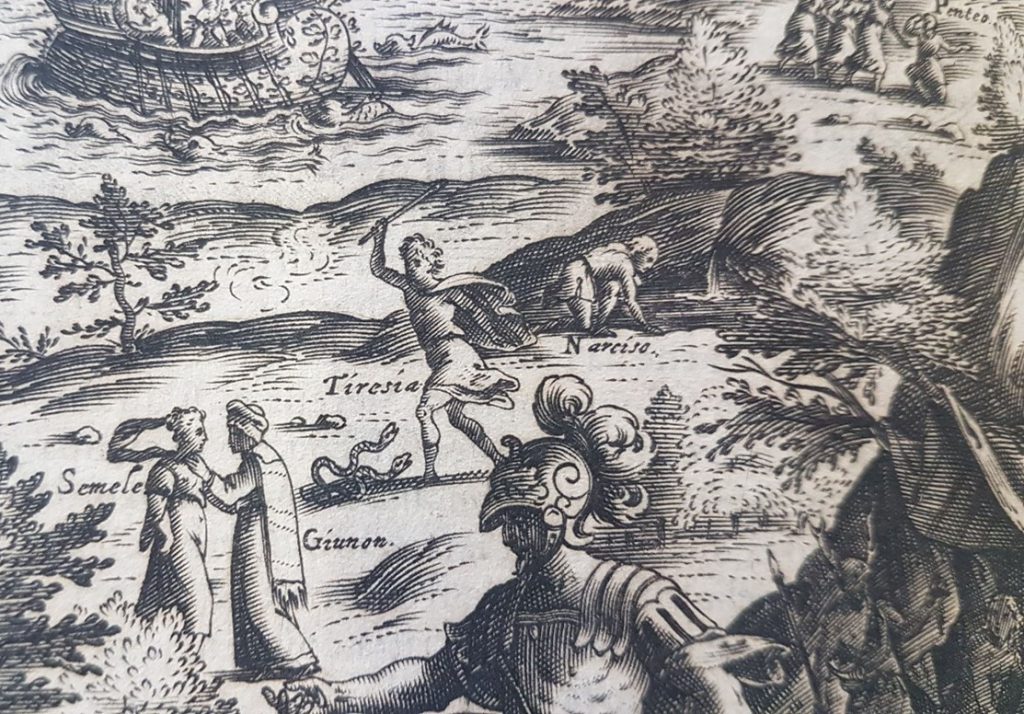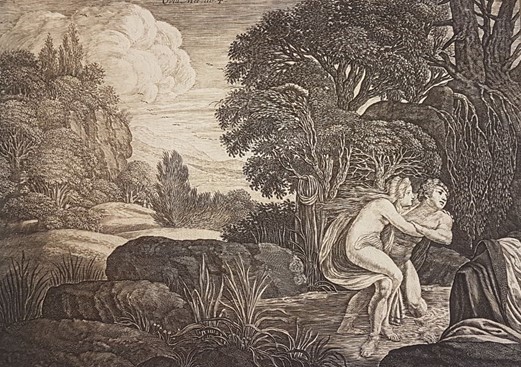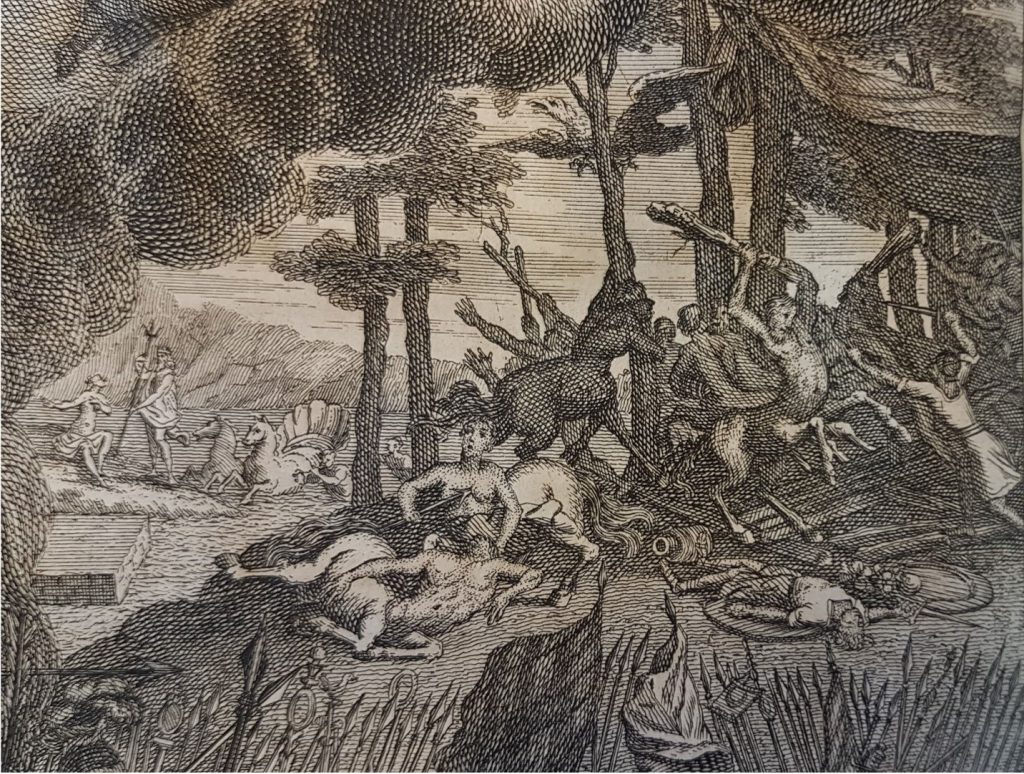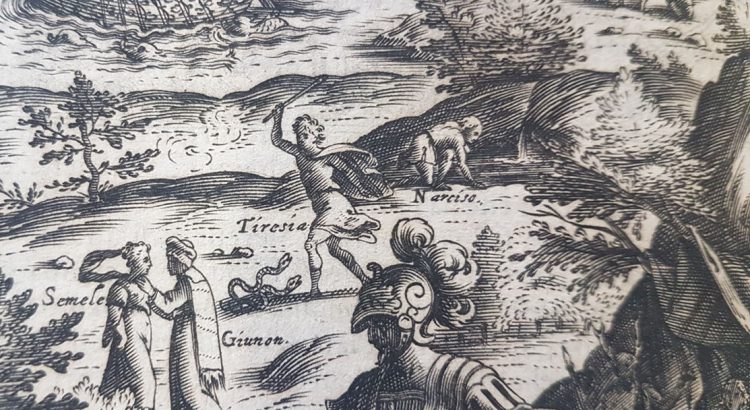Ovid’s Metamorphoses has almost 12,000 lines and covers over two hundred and fifty Greek Myths. As the name suggests each of these myths involves some kind of transformation for the characters within it.
Some of these transformations are from mortal to immortal, from human to animal and from human to plant, as well as a variety of other changes. The library holds over 150 editions of Metamorphoses, dating from 1542 to 2017. Many contain illustrations and etchings. In this blog post, I will retell the stories of four transformations across gender lines which occur in Metamorphoses.
In this blog post, I will be following the practise of the texts themselves which means changing the use of names and pronouns at the time of transformation.
Tiresias
The first figure who undergoes a transformation of gender in Metamorphoses is Tiresias in Book III. Interestingly the focus of this episode is not Tiresias’s transformation but how his lived experience would allow him to be a suitable judge in a debate.
The section relates how Tiresias was transformed into a woman after striking a pair of snakes and was seven years later transformed back after encountering the snakes again. Thus Zeus and Hera decide he is the perfect judge for their debate on sexual relations, having had experience in both bodies.

Salmacis & Hermaphroditus
The second episode which covers gender transformation is Salmacis and Hermaphroditus from Book IV. From the beginning of this episode Salmacis is singled out as a figure who does not conform to the roles as she should, being the only nymph who never wanted to join Diana’s hunters.
Upon seeing Hermaphroditus bathing in her pool, she becomes enamoured with him and after failing to seduce him she attacks him and asks the gods to ensure that they are never parted. True to form the gods grant her wish, but not as she might have wanted, fusing their bodies together leaving Hermaphroditus as the surviving consciousness in a now intersex body.
Enraged by the non-consensual transformation of his body by his attacker, Hermaphroditus calls upon his godly parents to curse the waters of Salmacis’s beloved pool so that anyone who enters it leaves similarly transformed.

Iphis & Ianthe
This story, from Book IX, begins with Iphis’s father informing her mother that they do not have the means to produce a dowry for a daughter. Thus if her pregnancy produces a daughter they will have to kill the child. Her mother, distraught at this, prays to the gods to help her. She is answered by Isis who tells her not to fear as she will help protect the child.
Iphis’s mother successfully raises her as a boy until her teenage years, when Iphis is betrothed to Ianthe. Deeply in love with Ianthe, but knowing that the wedding night will reveal her physical body, Iphis despairs. On the eve of her wedding night Iphis and her mother pray to Isis to help them. Isis descends and physically transforms him into a man.
The episode ends with Iphis and Ianthe’s wedding being witnessed by the gods of marriage and love.

Caenis/Caenus
Found in Book XII, the figure of Caenus appears not in person but as a tale narrated by Nestor at Troy. It begins with Caenis’s sexual assault at the hands of the sea god Poseidon. Following this attack Poseidon offers to grant her a gift. Caenis asks to be transformed into a man and Poseidon also gifts her with impenetrable skin.
Now named Caenus, he develops a reputation as a fierce warrior. While battling a group of centaurs, Caenus kills one of their great warriors, Latreus, after he mocks him, calling on Caenus to return to womanhood and abandon his warrior role. However this victory reveals to his enemies that his skin is impenetrable and they bury him in a pile of trees to suffocate. Nestor ends the story with his friend seeing Caenus, now having been transformed into a bird, emerge from the pile. This inspires his fellow warriors to finally drive off the centaurs’ attack.

Alex Wilson
LGBT+ History Intern
Items Featured:
Ovid. Metamorphoses d’Ovide en rondeaux / et dediez à monseigneur le dauphin.. Amsterdam: Chez Abraham Wolfgang, 1679.
Ovid. Le Metamorfosi de Ouidio. In Vin: Presso Bern Giunti, 1584.
Ovid. Ovid’s Metamorphoses in fifteen books. Translated by the most eminent hands. Adorn’d with sculptures. London: Printed for Jacob Tonson, 1717.
Ovid. Duryer, Pierre. Les Metamorphoses d’Ovide : en latin et françois, divisées en XV. livres. Amsterdam. P & J Blaeu, Jassons a Waesberge, Boom and Goethals, 1702.
